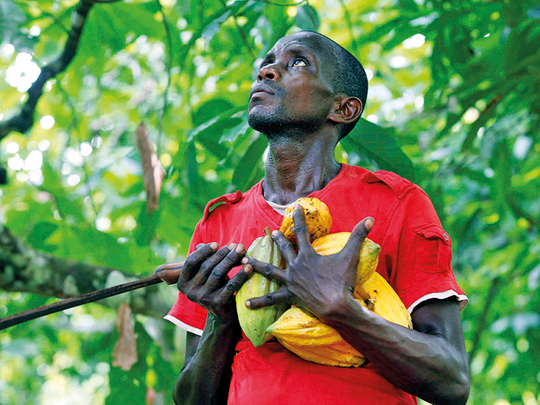
A week ago, in the Ivorian city of Abidjan, the sound of gunshots reverberated through the streets. Offices, schools and banks in the city’s financial district shut their doors, and most of the population remained safely behind them. Outside, a mutiny was taking place.
Over four days, former rebels who are now part of the country’s army revolted over pay, claiming they have not been paid promised bonuses. They had fought for years in support of President Alassane Ouattara, and now they wanted money for it. A similar protest in January resulted in a government agreement to pay them pounds 12,000 (Dh57,278) each, but more than pounds 7,000 is still due.
This is where the problem lies, because Ivory Coast does not have the cash. As the world’s biggest cocoa exporter, it has been severely affected by a dramatic drop in the price of cocoa over the last nine months, to such an extent that it was forced to slash its national budget by 10 per cent earlier this year. That was cheered by consumers in the UK this Easter, when the price of chocolate eggs was down 17 per cent, but in West Africa it has sparked fears of civil war.
The supply of cocoa is extremely concentrated. According to data from Euromonitor International, Ivory Coast alone accounts for more than 40 per cent of global production, while a further 20 per cent comes from nearby Ghana, which said last month that it had lost out on almost $1 billion (Dh3.6 billion) in export earnings due to the fall in prices. Ivory Coast was named the fastest-growing economy in Africa by the International Monetary Fund (IMF) in April 2016. How things change. Two weeks ago, the price of cocoa was $1,780 per tonne, its lowest in almost a decade and 45 per cent lower than in June last year. Even now, after a minor rally due to political instability caused by last weekend’s mutiny, it is trading at around $2,058 per tonne, still down more than 36 per cent compared with the prices from less than a year ago.
A series of factors have combined to wreak havoc on these still-developing markets. The first is demand. “For years we were working with a scenario of low supply and high and fast-growing demand, particularly in the new markets of China and India,” says Kristy Leissle, a cocoa marketer for the Twin and Twin trading company and a lecturer on the global chocolate industry at the University of Washington Bothell.
Now, however, that demand is failing to meet expectations. There are similar problems in the mature western markets, too, where a growing trend of health consciousness and anti-sugar lobbying means demand in the West is starting to plateau. The situation is exacerbated by a more pressing issue, though: massive oversupply.
Around 4 million tonnes of cocoa are produced each year, yet this year’s surplus is expected to come in at between 350,000 tonnes and 400,000 tonnes, around 10 per cent of production. It marks a dramatic shift from recent years, where the price of cocoa shot up due to fears over the Ebola crisis and then the strongest El Nino, the weather phenomenon that takes place when ocean temperatures rise in the eastern Pacific, in almost two decades. “El Nino weather tends to be detrimental to the production of cocoa so we had less cocoa produced than we might have done, leading to high prices,” says Jonathan Parkman, co-head of agriculture at Marex Spectron, one of the world’s biggest brokers of cocoa. “This year we have had much better weather, the crops have recovered, but demand has not yet recovered because the fall in prices is yet to feed through to the consumer.”
So what the farmers in West Africa are left with is essentially the worst-case scenario: abundant supply and poor demand.
A third factor is that the Ivorian government brought in a forward sales system in 2012. Ghana had successfully employed a similar method before, so it made economic sense at the time to sell the crop forward to protect themselves from sudden fluctuations in the market. For the trading giants such as Cargill and Barry Callebaut, this was not an issue but it was for smaller, local companies which, in the words of Parkman, “did not have the ability to hedge their purchases”.
For around four years, this approach proved profitable, and the warnings of the high-risk nature of such a policy were largely ignored. But then in January this year it was revealed that an Ivorian cocoa exporters’ association, which includes 16 local companies, would have to default on around 80,000 tonnes of export contracts. “The local companies were speculating,” says Parkman. “Some of the bigger companies made huge amounts of money buying from Ivory Coast and selling it. Those chickens came home to roost this year when they did this forward speculation and the markets plummeted, and there were a large number of local companies who were unable to continue.”
It was reported that up to 80 per cent of cocoa buyers had reneged on their contracts, so farmers stopped getting paid. Their cause was not helped by the country reducing the price it guarantees for cocoa farmers by 36 per cent in March and, after rising steadily since the implementation of the forward sales system in 2012, the amount paid to Ivorian farmers, who already operate on tiny margins, has fallen off a cliff. “Farmers are making much less money on more crop,” says Leissle. “So right now the price drop is impacting them in a tremendously negative way. “We see this on a daily basis, but at the same time they are growing more, so it is a really tough situation.”












